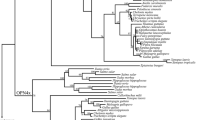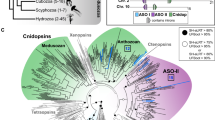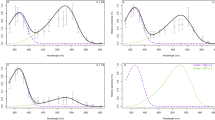Abstract
Peropsin, a member of the opsin family, has characteristics of two functionally distinct opsin-groups, that is, amino acid residues conserved among opsins for light-sensing and a retinal-photoisomerase-like molecular property. Although such a bilateral feature of peropsin seems to be important for understanding the diversity of the opsin family, previous studies have been limited to higher deuterostome, vertebrate and amphioxus peropsins. Here, we report a protostome peropsin homologue from a jumping spider. We found a spider opsin that shares amino acid homology and conserved amino acid residues with known peropsins. The spider opsin-based pigment heterologously expressed in cultured cells exhibited photoisomerase-like isomerization characteristics and a bistable nature. Based on the characteristics of both the amino acid homology and its photochemical properties, we concluded that the spider opsin is the first protostome peropsin homologue. These results show that peropsin existed before the deuterostome–protostome split like other members of the opsin family. In addition, the spider peropsin was localized to non-visual cells in the retina, and fluorescence from reduced retinal chromophore was also observed in the region where peropsin was localized. These findings provide the first demonstration that the peropsin can form a photosensitive pigment in vivo and underlie non-visual function.






Similar content being viewed by others
References
Chen P, Hao W, Rife L, Wang XP, Shen D, Chen J, Ogden T, Van Boemel GB, Wu L, Yang M, Fong HK (2001) A photic visual cycle of rhodopsin regeneration is dependent on Rgr. Nat Genet 28:256–260
Gärtner W (2000) Invertebrate visual pigments. In: Stavenga DG, DeGrip WJ, Pugh EN Jr (eds) Handbook of biological physics, vol 3. Elsevier Science, Amsterdam, pp 297–388
Hao W, Fong HK (1999) The endogenous chromophore of retinal G protein-coupled receptor opsin from the pigment epithelium. J Biol Chem 274:6085–6090
Hara T, Hara R (1967) Rhodopsin and retinochrome in the squid retina. Nature 214:573–575
Hara T, Hara R (1968) Regeneration of squid retinochrome. Nature 219:450–454
Katoh K, Misawa K, Kuma K, Miyata T (2002) MAFFT: A novel method for rapid multiple sequence alignment based on fast Fourier transform. Nucleic Acids Res 30:3059–3066
Kojima D, Oura T, Hisatomi O, Tokunaga F, Fukada Y, Yoshizawa T, Shichida Y (1996) Molecular properties of chimerical mutants of gecko blue and bovine rhodopsin. Biochemistry 35:2625–2629
Koyanagi M, Terakita A (2008) Gq-coupled rhodopsin subfamily composed of invertebrate visual pigment and melanopsin. Photochem Photobiol 84:1024–1030
Koyanagi M, Ono K, Suga H, Iwabe N, Miyata T (1998) Phospholipase C cDNAs from sponge and hydra: antiquity of genes involved in the inositol phospholipid signaling pathway. FEBS Lett 439:66–70
Koyanagi M, Terakita A, Kubokawa K, Shichida Y (2002) Amphioxus homologs of Go-coupled rhodopsin and peropsin having 11-cis- and all-trans-retinals as their chromophores. FEBS Lett 531:525–528
Koyanagi M, Kawano E, Kinugawa Y, Oishi T, Shichida Y, Tamotsu S, Terakita A (2004) Bistable UV pigment in the lamprey pineal. Proc Natl Acad Sci USA 101:6687–6691
Koyanagi M, Kubokawa K, Tsukamoto H, Shichida Y, Terakita A (2005) Cephalochordate melanopsin: Evolutionary linkage between invertebrate visual cells and vertebrate photosensitive retinal ganglion cells. Curr Biol 15:1065–1069
Koyanagi M, Nagata T, Katoh K, Yamashita S, Tokunaga F (2008a) Molecular evolution of arthropod color vision deduced from multiple opsin genes of jumping spiders. J Mol Evol 66:130–137
Koyanagi M, Takano K, Tsukamoto H, Ohtsu K, Tokunaga F, Terakita A (2008b) Jellyfish vision starts with cAMP signaling mediated by opsin-Gs cascade. Proc Natl Acad Sci USA 105:15576–15580
Ozaki K, Hara R, Hara T (1983) Histochemical localization of retinochrome and rhodopsin studied by fluorescence microscopy. Cell Tissue Res 233:335–345
Sun H, Gilbert DJ, Copeland NG, Jenkins NA, Nathans J (1997) Peropsin, a novel visual pigment-like protein located in the apical microvilli of the retinal pigment epithelium. Proc Natl Acad Sci USA 94:9893–9898
Suzuki T, Narita K, Yoshihara K, Nagai K, Kito Y (1995) Phosphatidyl-inositol phospholipase-C in squid photoreceptor membrane is activated by stable metarhodopsin via GTP-binding protein, Gq. Vision Res 35:1011–1017
Terakita A (2005) The opsins. Genome Biol 6:213
Terakita A, Hara R, Hara T (1989) Retinal-binding protein as a shuttle for retinal in the rhodopsin retinochrome system of the squid visual cells. Vision Res 29:639–652
Terakita A, Koyanagi M, Tsukamoto H, Yamashita T, Miyata T, Shichida Y (2004) Counterion displacement in the molecular evolution of the rhodopsin family. Nat Struct Mol Biol 11:284–289
Terakita A, Tsukamoto H, Koyanagi M, Sugahara M, Yamashita T, Shichida Y (2008) Expression and comparative characterization of Gq-coupled invertebrate visual pigments and melanopsin. J Neurochem 105:883–890
Tsukamoto H, Terakita A, Shichida Y (2005) A rhodopsin exhibiting binding ability to agonist all-trans-retinal. Proc Natl Acad Sci USA 102:6303–6308
Acknowledgments
We thank Robert S. Molday (University of British Columbia) for his kind supply of rho 1D4-producing hybridoma. This work was supported in part by grants-in-aid for Scientific Research from the Japanese Ministry of Education, Science, Sports, and Culture (to M.K. and A.T.). T.N. is supported by Research Fellowships of the Japan Society for the Promotion of Science for Young Scientists.
Author information
Authors and Affiliations
Corresponding author
Rights and permissions
About this article
Cite this article
Nagata, T., Koyanagi, M., Tsukamoto, H. et al. Identification and characterization of a protostome homologue of peropsin from a jumping spider. J Comp Physiol A 196, 51–59 (2010). https://doi.org/10.1007/s00359-009-0493-9
Received:
Revised:
Accepted:
Published:
Issue Date:
DOI: https://doi.org/10.1007/s00359-009-0493-9




